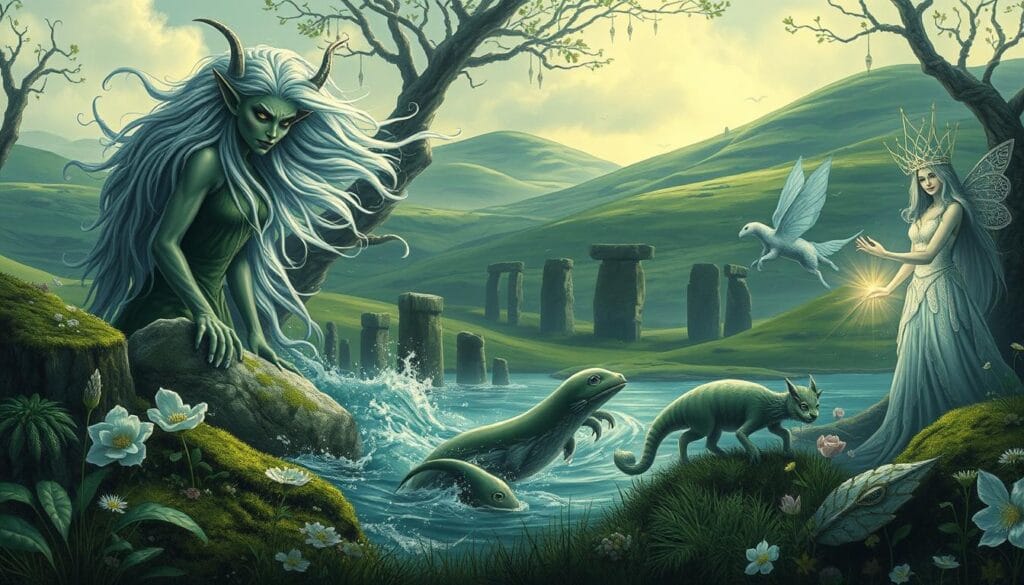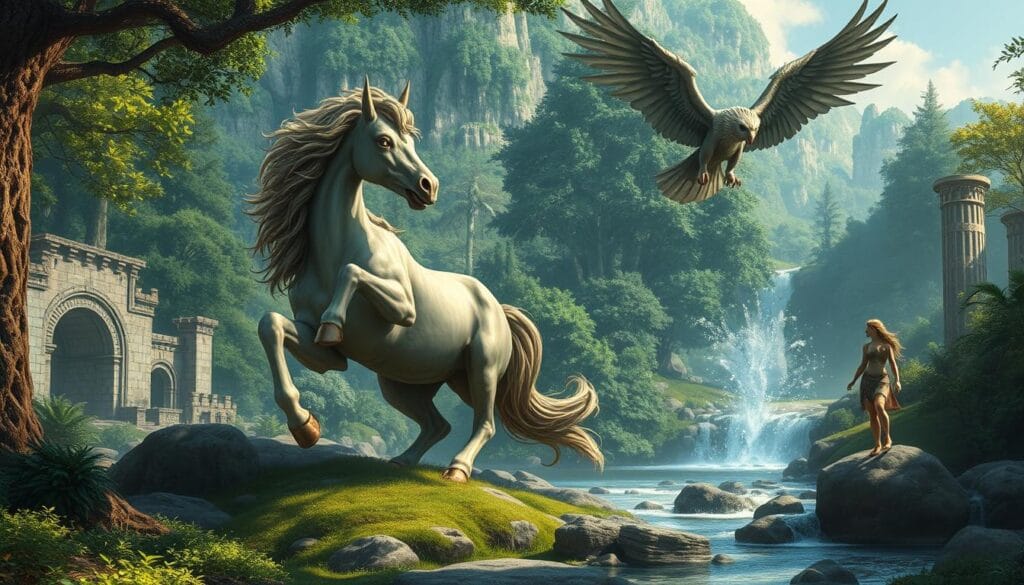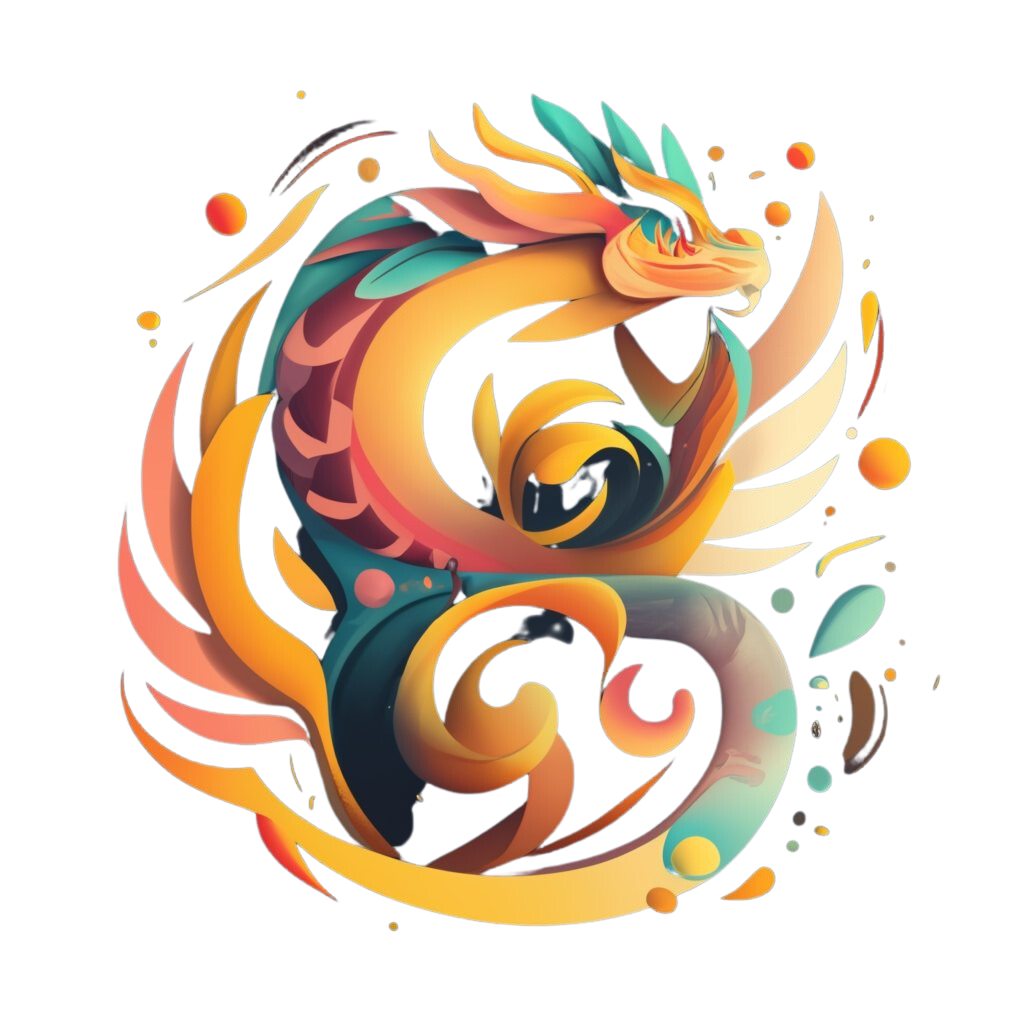Imagine a misty morning in Ireland. As the sun rises, it casts a magical glow over the green hills. You can almost hear ancient legends carried on the breeze. These tales tell of fantastical beasts, powerful gods, and enchanting spirits that have fascinated people for centuries.
The folklore and mythology of Europe is a rich mix of stories from cultures across the continent. From the snow-capped mountains of Scandinavia to the sun-drenched shores of Greece, these legends are woven together.
As you read on, you’ll journey through the world of European mythical creatures. You’ll meet the wailing banshees and mischievous leprechauns of Ireland. You’ll also learn about the fierce valkyries and cunning shape-shifters of Norse mythology.
The ancient Greeks told stories of half-man, half-horse centaurs and the fearsome Minotaur. Celtic folklore is filled with tales of supernatural water horses known as kelpies and the enigmatic Green Man, a symbol of nature’s cycles.
So, sit back, let your imagination soar, and get ready to be enchanted by European mythical creatures. These timeless tales inspire and fascinate us, offering insights into the human experience. They are more than just stories; they are a legacy that connects us to our cultural heritage and the power of storytelling.
Key Takeaways
-
- European mythology is a rich tapestry of ancient stories, folklore, and legends from various cultures
-
- Mythical creatures like banshees, leprechauns, centaurs, and kelpies have captured imaginations for centuries
-
- These legends serve as allegories and reflections of the human experience that still resonate today
-
- Exploring European mythical creatures connects us to our cultural heritage and the power of storytelling
-
- The enduring fascination with these fantastical beasts continues to inspire modern fantasy and imagination
Exploring the Rich Tapestry of European Mythology
European mythology is a colorful mix of stories and legends. These tales show the rich cultural heritage of the continent. They come from all over, from Ireland’s misty shores to Scandinavia’s snowy peaks.
At the heart of these myths is storytelling. For ages, people have shared these tales by word of mouth. They’d gather to hear stories of gods, monsters, and heroes, creating a world of wonder.
European mythological creatures reflect the values and dreams of their cultures. Dragons from Norse myths symbolize strength and wisdom. Leprechauns from Irish tales show the playful side of life. Each creature tells a story, giving us a peek into the beliefs of old.
These myths still captivate us today. They speak to our deep desires for adventure and the unknown. Exploring European mythology helps us appreciate the diversity of human stories.
| Mythological Tradition | Key Features | Famous Creatures |
| Irish | Emphasis on nature, magic, and the supernatural | Banshees, Leprechauns, Púcas |
| Norse | Tales of gods, heroes, and epic battles | Valkyries, Trolls, Nidhogg |
| Greek | Complex pantheon of gods and legendary figures | Centaurs, Minotaur, Sirens |
Irish Mythical Creatures
Ireland is a land full of Celtic folklore. Stories of supernatural beings and fairy folk have been shared for generations. These creatures are a big part of Irish culture and fascinate people everywhere. Let’s look at three famous Irish mythical creatures: the banshee, leprechauns, and the púca.
The Banshee: Harbinger of Death

The banshee is a ghost in Irish myths. She’s known for her loud wails that warn of a family member’s death. She’s often seen as a woman with long hair and wears white or gray. Her cries at night can make people shiver.
Leprechauns: Mischievous Guardians of Treasure
Leprechauns are famous Irish creatures. They’re small men with beards, wearing green. They’re good at making shoes and guard hidden treasure. But, they’re tricky to catch because of their cleverness.
The Púca: Shape-Shifting Tricksters
The púca can change shape in Irish myths. It can be a horse, goat, or rabbit. These creatures love to play tricks on humans. But, they also give advice to those who treat them well.
| Creature | Description | Associated with |
| Banshee | Ghostly woman who wails to foretell death | Death and mourning |
| Leprechaun | Small, bearded shoemaker; guards treasure | Luck, mischief, and wealth |
| Púca | Shape-shifting trickster; takes animal forms | Mischief, advice, and guidance |
These Irish mythical creatures are loved by people all over the world. They show the lasting impact of Celtic folklore. From the banshee’s haunting cries to the púca’s fun tricks, they are key parts of Ireland’s culture.
Norse Mythical Creatures and Legends
Explore the world of Viking mythology and Scandinavian folklore. Here, Norse gods and mythical beasts rule. Creatures like valkyries and trolls have amazed people for centuries.
Valkyries: Choosers of the Slain
Valkyries are fierce female warriors in Norse mythology. They work for Odin, the god king. These battle-maidens pick the bravest warriors to join them in Valhalla.
There, the warriors feast and get ready for Ragnarök. It’s the final battle.
| Valkyrie Name | Meaning |
| Brynhildr | Armored warrior woman |
| Sigrún | Secret victory |
| Kára | The wild, stormy one |
Trolls: Fearsome and Territorial Beings
Trolls are huge, scary creatures in Scandinavian folklore. They are ugly and not very smart. But they are very protective of their land.
They turn to stone in sunlight. This is why you see weird rocks in the Nordic lands.
Nidhogg: The Serpent That Gnaws at Yggdrasil
Nidhogg is a big serpent at Yggdrasil’s roots. It tries to destroy the tree. This shows the danger to the Norse world.
The Norns keep Yggdrasil alive. They water and care for it. This keeps the world balanced.
These creatures and stories still fascinate us. They show the deep storytelling of Viking and Scandinavian lore. From valkyries to trolls and Nidhogg, they paint a vivid picture of the Norse world.
Greek Mythical Creatures

The myths of ancient Greece have amazed people for centuries. They have created some of the most famous creatures in European mythology. These stories have deeply influenced Western culture, inspiring many works of art, literature, and media.
Greek mythology is full of fantastical beings. From the mighty gods and goddesses of Olympus to the scary monsters that tested heroes, it’s rich. A few creatures have become very well-known and important in our culture.
Centaurs: Half-Man, Half-Horse Hybrids
Centaurs are half-man, half-horse and very well-known. They are seen as wild and unpredictable, often drunk and violent. But, some like Chiron were wise and helped heroes like Achilles.
The Minotaur: The Beast of the Labyrinth
The Minotaur was a scary creature with a bull’s head and a man’s body. It was the child of Queen Pasiphae of Crete and a sacred bull. Trapped in Daedalus’s labyrinth, it demanded sacrifices from Athens until Theseus killed it. Its story is a classic in Greek mythology.
Sirens: Enchanting Temptresses of the Sea
Sirens were sea creatures that sang to lure sailors to their deaths. They were half-woman, half-bird and famous in Homer’s Odyssey. Odysseus had to find a way to avoid their song. Sirens symbolize the dangers of temptation and the need to stay focused.
These creatures from Greek mythology still fascinate people everywhere. They remind us of the power of stories and the rich heritage of ancient Greece.
British Mythical Creatures
The United Kingdom is filled with legendary beasts and mythical beings. These creatures have amazed people for centuries. From Scotland’s misty moors to Wales’ enchanted forests, English folklore is full of tales of extraordinary creatures.
The unicorn is a symbol of purity and magic in British folklore. It’s a white horse with a single horn. Only those with a pure heart can find these creatures, and their horns can heal.
Pixies are tiny, winged creatures in English folklore. They live in British gardens and woodlands. Pixies love to play tricks and dance, but they can also help lost travelers.
Dragons are legendary beasts in British folklore. Knights often battled dragons to protect the innocent. The most famous dragon story is about St. George, England’s patron saint.
Other mythical beings include the green man, selkies, and ghostly black dogs. These creatures have inspired many works of art and literature. Their stories continue to captivate people today.
Celtic Mythical Creatures
The Celtic nations of Europe, including Ireland, Scotland, and Wales, have a rich tapestry of mythology and folklore. These stories have captivated people for centuries. Among the most fascinating are the mythical creatures that inhabit these ancient tales. The kelpies and the Green Man are two such creatures, showing the deep connection between the Celtic people and nature.
Kelpies: Supernatural Water Horses
Kelpies are shape-shifters that take the form of beautiful horses. They lure unsuspecting travelers to their doom. These nature spirits haunt the lochs and rivers of Scotland, tempting people to climb onto their backs before dragging them into the water to drown.
Kelpies are often described as having a mane that is constantly dripping with water. Their skin is said to be as cold as ice.
The origins of the kelpie legend are unclear. Some believe they were inspired by the real-life dangers of Scotland’s waterways. The pagan beliefs of the Celtic people also likely played a role, as water was seen as a gateway to the otherworld in Celtic mythology.
The Green Man: Symbol of Nature and Rebirth
The Green Man is another iconic figure in Celtic mythology. He represents the spirit of nature and the cycle of life, death, and rebirth. This enigmatic figure is often depicted as a face surrounded by leaves and foliage, found in countless works of art and architecture throughout the Celtic nations.
The Green Man is thought to embody the vitality and regenerative power of nature. He serves as a reminder of the interconnectedness of all living things. In pagan beliefs, the Green Man was often associated with the gods of vegetation and fertility, and his image was used in rituals and celebrations marking the changing of the seasons.
| Creature | Description | Symbolism |
| Kelpie | Shape-shifting water horse | Dangers of nature, pagan beliefs |
| Green Man | Face surrounded by foliage | Cycle of life, nature spirits |
The kelpie and the Green Man are just two examples of the many fascinating mythical creatures in Celtic folklore. These enduring legends show the deep connection between the Celtic people and nature. They continue to inspire and captivate people to this day.
German Mythical Creatures
Germany’s rich folklore and mythology have created many mythical creatures. These beings have fascinated people for centuries. They come from fairy tales and stories passed down through generations. They show the hopes, fears, and values of the German people.
We will look at two famous creatures: the kobolds and the werewolves. These beings are part of Germany’s long tradition of stories.
Kobolds: Mischievous Household Spirits
Kobolds are small, playful spirits that live in homes. They can help or cause trouble. If treated well, they bring good luck and help with chores. But if ignored, they play pranks.
Kobolds look different in different parts of Germany. Some look like gnomes, others like goblins. But they all love to play tricks and are close to their homes.
Werewolves: Cursed Shape-Shifters
Werewolves, or “Werwölfe” in German, are well-known creatures. They are humans who turn into wolves during the full moon. In wolf form, they are strong, have great senses, and crave human flesh.
Werewolves have been part of German stories for centuries. Some tales see them as tragic figures, others as monsters. They are often seen as struggling with their wild side.
| Creature | Description | Characteristics |
| Kobold | Mischievous household spirit | Small, humanoid; can be helpful or hindering |
| Werewolf | Human that transforms into a wolf-like creature | Superhuman strength, heightened senses, hunger for human flesh |
Werewolves have inspired many stories, books, and movies. They are a big part of popular culture. From Grimm’s fairy tales to today’s stories, they still fascinate and scare us.
Learn more about German Mythology here: German Mythical Creatures
The Enduring Fascination with European Mythical Creatures
For centuries, European mythical creatures have fascinated people. They influence today’s literature and pop culture. From fairy tales to movies, these beings are part of our shared stories. They symbolize the human experience in powerful ways.
The Influence of Mythology on Modern Fantasy
European mythology inspires many authors, filmmakers, and artists. Modern fantasy owes a lot to these old tales. Books like “The Lord of the Rings” and “The Chronicles of Narnia” use these myths to create magical worlds.
Today, mythical creatures are more popular than ever. Franchises like “Harry Potter,” “Game of Thrones,” and “Percy Jackson” have won fans worldwide. These stories entertain and introduce new themes and characters from European myths.
Mythical Creatures as Symbols and Allegories
Mythical creatures are more than just entertainment. They symbolize complex ideas and emotions. The unicorn stands for purity and innocence, while dragons represent greed and chaos.
These symbols are everywhere in pop culture, from art to ads. They add depth and meaning to works, connecting with our shared hopes and fears. By exploring these creatures, we keep their stories alive and make new connections between past and present.
Conclusion: Preserving the Legacy of European Mythical Creatures
Our journey into the world of European mythical creatures has shown us a wealth of stories. These tales have been loved for centuries. From the Irish banshee’s eerie cries to the Norse trolls’ magical changes, they’ve amazed people everywhere.
It’s clear that keeping these stories alive is crucial. In today’s world, it’s more important than ever to save our cultural heritage. By sharing these tales through art, books, and stories, we keep European myths alive. These legends entertain, inspire, and teach us valuable lessons about life.
Let’s honor and celebrate the mythical creatures that have enriched European folklore. By embracing their stories in our own tales, we keep their magic alive. Together, we can make sure these enchanting creatures continue to fascinate us for many years.
FAQ
What are some of the most famous European mythical creatures?
Famous creatures include the Irish banshee, leprechauns, and púca. The Norse have valkyries, trolls, and Nidhogg. Greek tales feature centaurs, the Minotaur, and sirens. German folklore is home to kobolds and werewolves.
How have European mythical creatures influenced modern fantasy literature?
These creatures have deeply influenced fantasy literature. They inspire authors and shape many stories. Today’s novels, films, and TV shows often draw from European myths, bringing these legends to new fans.
What role do mythical creatures play in European cultural heritage?
They are key to European culture, showing the beliefs and traditions of the past. These beings symbolize hopes, fears, and dreams of the people who believed in them.
Are there any similarities between the mythical creatures of different European cultures?
Yes, despite their unique stories, there are similarities. Many tales share themes like shape-shifting and water spirits. For example, the Irish púca and Norse trolls, or Celtic kelpies and Greek sirens.
Why is it important to preserve the stories and legends of European mythical creatures?
Saving these stories is vital for Europe’s cultural heritage. They offer a glimpse into the past and inspire today’s imagination. By keeping these tales alive, we honor European mythology’s enduring legacy.
